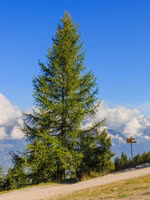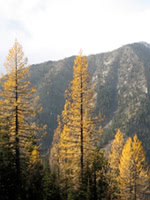Mon-Fri 9am - 5pm Mountain time
Western Larch vs European Larch
Larix decidua
Larix occidentalis
NOT AVAILABLE THIS SEASON - MIGHT RETURN
The European Larch is a large deciduous conifer that, like most larches, drops its needles before winter. Known for the soft green foliage that turns a stunning golden yellow in the fall. While young, it has a pyramidal shape with horizontal branching and drooping branches, but becomes more irregular as it matures.
The European Larch is an important timber tree in Europe.
Western Larch is a pioneer species that can survive in nutrient poor soil and is found in the valleys and on the lower slopes of mountains in mixed forests. In the warm months, this larch is covered in clusters of soft green needles that turn golden yellow before dropping in the fall. Its dense, sturdy wood is excellent for lumber, making this Larch valuable in Western North America.

